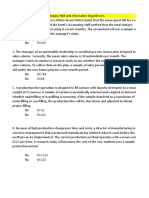Analysis of Variance Example
Uploaded by
Kim SalimAnalysis of Variance Example
Uploaded by
Kim SalimAnalysis of Variance Example
A manager wishes to determine whether the mean times required to complete a certain task differ for the three levels of employee training. He randomly selected 10 employees with each of the three levels of training (Beginner, Intermediate and Advanced). Do the data provide sufficient evidence to indicate that the mean times required to complete a certain task differ for at least two of the three levels of training? The data is summarized in the table.
Level of Training Advanced Intermediate Beginner
n 10 10 10 24.2 27.1 30.2
s2 21.54 18.64 17.76
Ha: The mean times required to complete a certain task differ for at least two of the three levels of training. Ho: The mean times required to complete a certain task do not differ the three levels of training. ( B = I = A) Assumptions: The samples were drawn independently and randomly from the three populations. The time required to complete the task is normally distributed for each of the three levels of training. The populations have equal variances. Test Statistic:
RR:
or
Calculations:
= 10(24.2 - 27.16...)2 +
10(27.1 - 27.16...)2 + 10(30.2 - 27.16...)2 = 180.066....
= 9(21.54) + 9(18.64) + 9(17.76) = 521.46
Source Treatments Error Total
df 2 27 29
SS 180.067 521.46 702.527
MS 90.033 19.313
F 4.662
Decision: Reject Ho. Conclusion: There is sufficient evidence to indicate that the mean times required to complete a certain task differ for at least two of the three levels of training.
Which pairs of means differ?
The Bonferroni Test is done for all possible pairs of means.
Decision rule: interval
Reject Ho, if the does not contain 0.
c = # of pairs c = p(p-1)/2 = 3(2)/2 = 3
t.0083 = 2.554 (This value is not in the t table; it was obtained from a computer program.) Since t.010 < t.0083 < t.0050 (2.473 < t.0083 < 2.771), use t.005 when using a table. If you reject the null hypothesis when t = 2.771; you will also reject it for t.0083.
There is sufficient evidence to indicate that the mean response time for the advanced level of training is less than the mean response time for the beginning level. There is not sufficient evidence to indicate that the mean response time for the intermediate level differs from the mean response time of either of the other two levels.
You might also like
- Basic Knowledge Mechanical Materials Testing Methods EnglishNo ratings yetBasic Knowledge Mechanical Materials Testing Methods English5 pages
- PDF Modern Machining Technology Advanced Hybrid Micro Machining and Super Finishing Technology 1st Edition Bijoy Bhattacharyya download100% (4)PDF Modern Machining Technology Advanced Hybrid Micro Machining and Super Finishing Technology 1st Edition Bijoy Bhattacharyya download50 pages
- Predetermined Time Systems (PTS) Using MTMNo ratings yetPredetermined Time Systems (PTS) Using MTM13 pages
- Approximation of Optimal Profile of Rolling Bearings Cylindrical RollersNo ratings yetApproximation of Optimal Profile of Rolling Bearings Cylindrical Rollers15 pages
- Application of Integrated Taguchi and TOPSIS Method For Optimization of Process Parameters For Dimensional Accuracy in Turning of EN25 SteelNo ratings yetApplication of Integrated Taguchi and TOPSIS Method For Optimization of Process Parameters For Dimensional Accuracy in Turning of EN25 Steel9 pages
- En 14399 & en 15048 FPC Points To Be CoveredNo ratings yetEn 14399 & en 15048 FPC Points To Be Covered8 pages
- Using DMAIC Six Sigma To Systematically Improve Shopfloor Production Quality and CostsNo ratings yetUsing DMAIC Six Sigma To Systematically Improve Shopfloor Production Quality and Costs20 pages
- PQCDSM KPI Definitions. Part 2 - Continuously Improving ManufacturingNo ratings yetPQCDSM KPI Definitions. Part 2 - Continuously Improving Manufacturing34 pages
- Overall Equipment Efficiency (OEE) : © Russel Timothy, Assoc - ProfessorNo ratings yetOverall Equipment Efficiency (OEE) : © Russel Timothy, Assoc - Professor9 pages
- Nonparametric Methods:: Analysis of Ranked Data100% (1)Nonparametric Methods:: Analysis of Ranked Data30 pages
- Basic Knowledge Mechanical Materials Testing Methods EnglishBasic Knowledge Mechanical Materials Testing Methods English
- PDF Modern Machining Technology Advanced Hybrid Micro Machining and Super Finishing Technology 1st Edition Bijoy Bhattacharyya downloadPDF Modern Machining Technology Advanced Hybrid Micro Machining and Super Finishing Technology 1st Edition Bijoy Bhattacharyya download
- Approximation of Optimal Profile of Rolling Bearings Cylindrical RollersApproximation of Optimal Profile of Rolling Bearings Cylindrical Rollers
- Application of Integrated Taguchi and TOPSIS Method For Optimization of Process Parameters For Dimensional Accuracy in Turning of EN25 SteelApplication of Integrated Taguchi and TOPSIS Method For Optimization of Process Parameters For Dimensional Accuracy in Turning of EN25 Steel
- Using DMAIC Six Sigma To Systematically Improve Shopfloor Production Quality and CostsUsing DMAIC Six Sigma To Systematically Improve Shopfloor Production Quality and Costs
- PQCDSM KPI Definitions. Part 2 - Continuously Improving ManufacturingPQCDSM KPI Definitions. Part 2 - Continuously Improving Manufacturing
- Overall Equipment Efficiency (OEE) : © Russel Timothy, Assoc - ProfessorOverall Equipment Efficiency (OEE) : © Russel Timothy, Assoc - Professor



























































